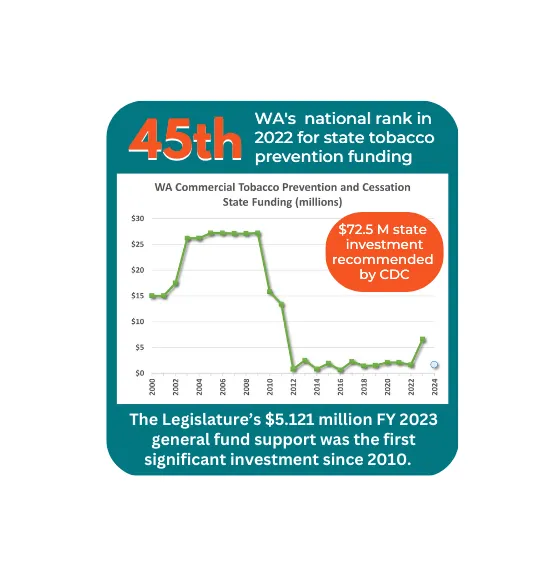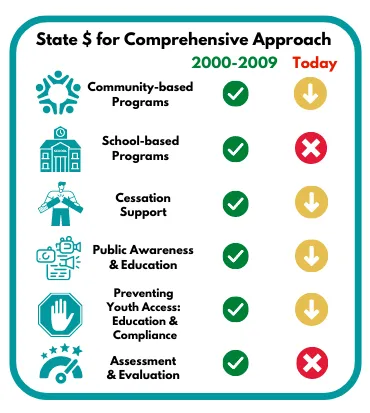Sources: Reinvesting Statement
Data sources for the statement: Reinvesting in a Comprehensive Commercial Tobacco Prevention & Treatment Program is Critical
This page provides data and information sources for the coalition's position statement: Reinvesting in a Comprehensive Commercial Tobacco Prevention & Treatment Program is Critical for the Health of Washingtonians
104,000 youth
will die prematurely from smoking
$846.7 Million
in state Medicaid program health expenditures caused by tobacco use
27%
of cancer deaths are due to smoking
8,300 Deaths
from smoking each year
$3.26 Billion
in annual health care expenditures directly caused by tobacco use
$87.2 Million
in annual tobacco industry marketing in WA
Campaign for Tobacco-Free Kids: The Toll of Tobacco in Washington (Oct. 2022)
The Need For Funding
Washington State ranked 45th in the nation in FY 2022 for its state investment in commercial tobacco prevention and cessation treatment (Campaign for Tobacco-Free Kids: FY2022 State Rankings: States Ranked by Percent of CDC-Recommended Funding Levels)
The Campaign For Tobacco-Free Kids released its FY 2023 State Rankings report on January 13, 2023. In FY 2023, WA’s national ranking improved to 33rd in the nation due to the Legislature’s state general fund investment of $5.121 million combined with a $1.47 million appropriation from state tobacco license/fines.
State funding amounts from fiscal years 2000-2022 for the WA Commercial Tobacco Prevention and Cessation Program were obtained through a data request to the WA Department of Health’s Commercial Tobacco Prevention Program.
See also this WA DOH fact sheet showing program funding from 2000-2020.
- From 2000 to 2009, WA invested ~$23.6M per year of state funds towards preventing smoking and helping people stop using nicotine.
- In response to the 2008 recession, WA State eliminated that state support, including all funds from the tobacco industry’s Master Settlement Agreement payments.
- These cuts left the program less than $2.3 million per year, almost entirely from state tobacco licenses and fines, to provide services and support statewide from FY 2012-2022.
- In FY 2023, the Legislature made a start at reinvesting in the Commercial Tobacco Prevention Program by approving $5.121 million in the Supplemental Operating Budget from the general fund. This was the first significant general fund investment since support was drastically reduced in 2010. This funding is critical to community-based prevention strategies and programs, addressing disparities in nicotine addiction in specific populations, and delivering basic cessation services
- The Governor's 2024 budget proposal does not sustain this critical state general fund investment. The FY 2024 data point represents just $1.641M from a portion of the state tobacco license and fine revenues in the Youth Tobacco and Vapor Products Prevention account.

The CDC recommends an annual state investment of $72.5 million in a comprehensive commercial tobacco control program.
In 2014, the CDC’s recommended state spending in WA for a comprehensive and effective commercial tobacco control program was $9.22 per capita or a total of $63.6 million.
Using WA OFM’s 2022 population estimate of 7,864,400 that amount adjusts to $72.51 million.
What Appropriate Funding Can Do
When the state prioritized state investments of approximately $23.6 million per year in a comprehensive commercial tobacco prevention program from 2000-2009, youth and adult smoking rates declined and economic analysis showed the state realized more than a 5:1 return on its investment through reduced healthcare costs.

- A 2011 study found that for every dollar spent by Washington’s tobacco prevention and control program between 2000 and 2009 (the period of highest investment), more than five dollars were saved by reducing hospitalizations for heart disease, stroke, respiratory disease and cancer caused by tobacco use. Julia A. Dilley, et al. “Program, Policy, and Price Interventions for Tobacco Control: Quantifying the Return on Investment of a State Tobacco Control Program”, American Journal of Public Health 102, no. 2 (February 1, 2012): pp. e22-e28. https://doi.org/10.2105/AJPH.2011.300506
- From 2001-2005, reductions in WA smoking prevalence under the comprehensive state tobacco control program exceeded national declines: overall smoking rates fell from 22.5% to 17.6% and youth smoking declined from 12.5% to 7.8%. Julia Dilley, et al. “Effective tobacco control in Washington State: a smart investment for healthy futures.” Prev Chronic Dis 2007 Jul;4(3):A65. https://pubmed.ncbi.nlm.nih.gov/17572969/
State Funding: Then & Now
The state’s 2000-2009 comprehensive commercial tobacco prevention and cessation program was funded to support five integrated program strategies: community-based programs, school-based programs, cessation services, public awareness and education, and preventing youth access. Assessment and evaluation was also funded.
- The program plan was developed through an inclusive process and is described in “A Tobacco Prevention and Control Plan For Washington State”, September 2000.
- Since state budget cuts in response to the Great Recession, the state has not funded a comprehensive program.
- $5.121 M in renewed state investment in FY 2023 was a start to restoring portions of the program.
